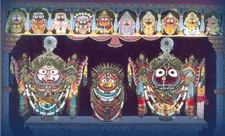The origins or the worship of Lord Jagannath and the temple dedicated to him in Jagannath puri are lost in the sands of history. Scholastic attempts to trace the same are superficial at best. The devout Hindu devotee believes that Lord Jagannath is eternal. Thus we have two versions of the origins. One is the popular legends based on Puranas and Folklore. The other is the statements of the scholars who have tried to collate evidences from known history, archeology and ancient literature to draw surmises about the history and the origins.
Click here to know the Legend of Lord Jagannath.
The history of the present temple goes back to about 12th century A.D. when the founder King of the Ganga Dynasty, King Chodaganga Deva began it’s construction. The construction was finished by King Anangabhima Deva. History records indicate that the temple existed in one form or the other since ancient times sometimes patronized by the Kings ruling Orissa at the time and sometimes having been neglected. From the times of the Ganga Kings that the temple received offical patronship fully. The King acknowledged Lord Jagannath is the actual ruler of the kingdom and he was his deputy.
Over the years, the royal worship continued until the invading Afghans defeated the Orissa Kings and plundered the temple in the 16th Century. The temple priests saved the deities from the invaders and preserved them secludedly. During the succeeding centuries, the Temple Administration and the Kingdom of Orissa had a very chequered history. Often the temple was invaded by the Muslim Moghuls, worship stopped and again it was restored. For some time, the Marathas ruled the Orissa region and during such time the temple worship went unhindered. However, the advent of the Imperial British East India Company and it’s successor British rule by the crown again brought the temple Management under stress. However, to the credit of the British it must be said that they respected the right to worship of the Hindus at Jagannath and indirectly allowed patronage. They recognized that Jagananth Puri's King of Orissa (Gajapati Maharaj) as the Superintendent of the Temple and granted some revenue rights and privileges to the temple to run it's affairs. |



